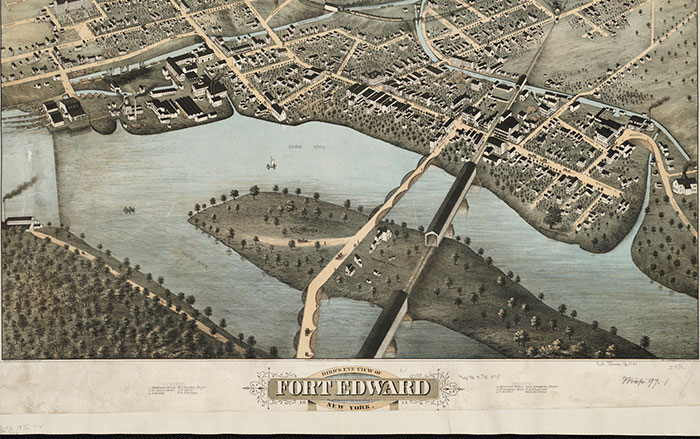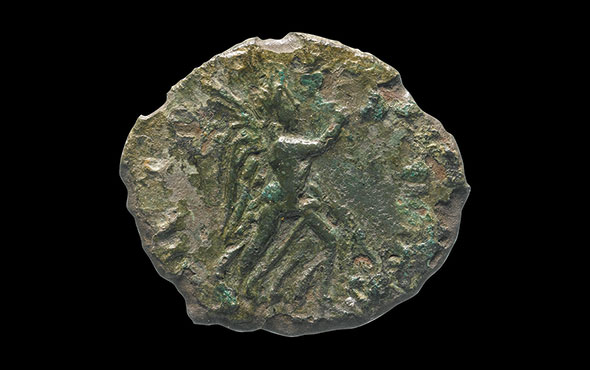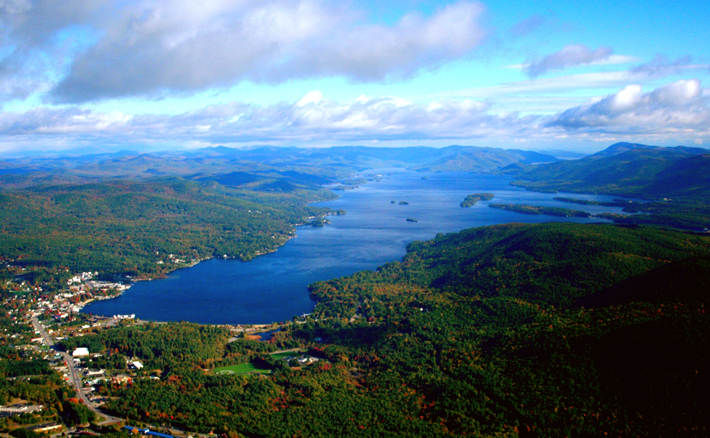
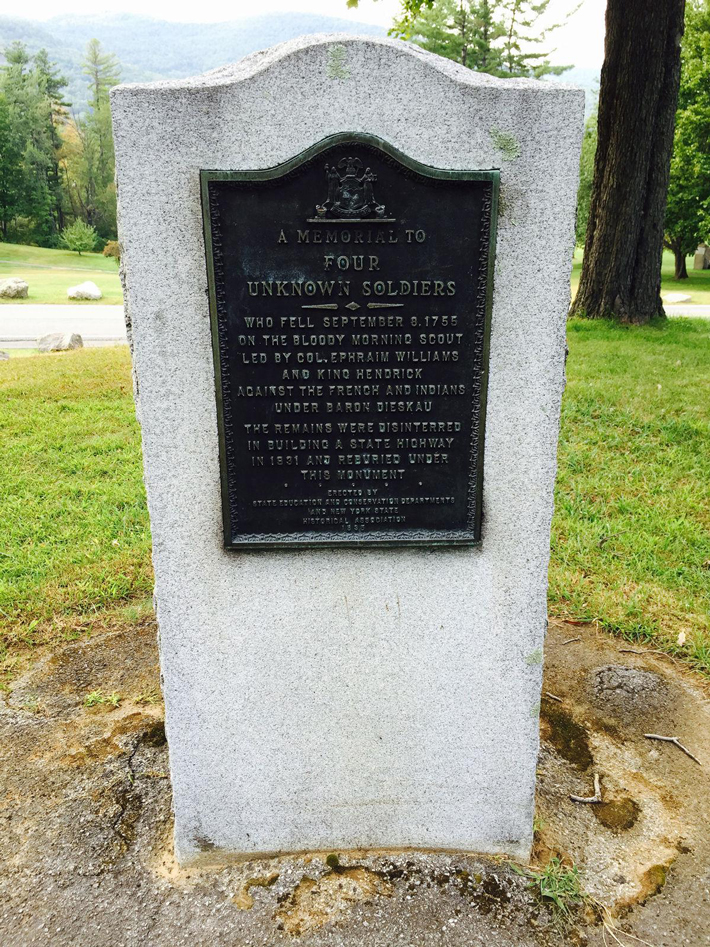
On a bluff above the southern shore of the picturesque Lake George stands a small granite memorial. A bronze plaque commemorates the burial of four soldiers who died nearby during the 1755 Battle of Lake George, an early skirmish in the French and Indian War, which pitted British forces against the French and their Native American allies. The men’s remains had been unexpectedly disturbed during road construction in the 1930s, and were eventually reinterred in their present location beneath the monument. They are believed to be the oldest unknown American soldiers in the United States.
This grim discovery is not altogether unusual for this region. There are many forgotten graves here, vestiges of a time when tens of thousands of soldiers roamed, fought, and died in these woods. “Given the long history of intense military activity here, I would expect that many additional unknown burials remain undiscovered in the area,” says Charles Vandrei, historic preservation officer with New York’s Department of Environmental Conservation. The sporadic encounters with fallen soldiers are reminders of a contentious chapter in North American history, when this frontier region was the chessboard on which two European superpowers played a bloody game that would determine the destiny of a continent.
Although today this section of upstate New York is bustling with throngs of summer tourists, 250 years ago it was harsh wilderness covered by tangled forests, marshy wetlands, and otherwise inhospitable terrain. It was also critically strategic territory, as it comprised a kind of no-man’s-land between French possessions in Canada and British possessions in New York and New England. War loomed on the horizon as each crown claimed the area as its own.
Most importantly, this region is notable for its natural network of nearly contiguous waterways that connects New York City to Montreal and Quebec via the Hudson River, Lake George, Lake Champlain, and the Richelieu and Saint Lawrence Rivers. In the days when overland travel was slow and burdensome, people, and especially armies, moved most efficiently on the water. During the French and Indian War (1754–1763), as the British and the French attempted to outjockey one another, whoever controlled these passages essentially controlled North America. As they prepared to battle over this land, it began its transformation into a war zone. The opposing sides erected a series of forts to defend their positions and to launch forays into enemy territory. The French built Fort Saint Frederic, which was renamed Crown Point when captured by the British, and Fort Carillon, later renamed Ticonderoga, along Lake Champlain. The British countered by building Fort William Henry on Lake George and Fort Edward on the Hudson River. These are among the more recognizable sites, but there are also many smaller, lesser-known examples scattered throughout the area. “The Lake George region—indeed the entire corridor of the upper Hudson Valley through to the Champlain Valley—contains the largest and most significant concentration of eighteenth-century military archaeological sites in North America,” says Vandrei.
Plymouth State University archaeologist David Starbuck refers to this stretch of sites in northeastern New York as the “Great Warpath.” Over the past several decades, archaeology has played a vital role in helping not only to reconstruct this military landscape, but also to delve deeper into the lives of the soldiers who lived and died here. Much of that work has been led by Starbuck, who was raised in the area and who has undertaken numerous archaeological projects there in cooperation with SUNY Adirondack over the last three decades.
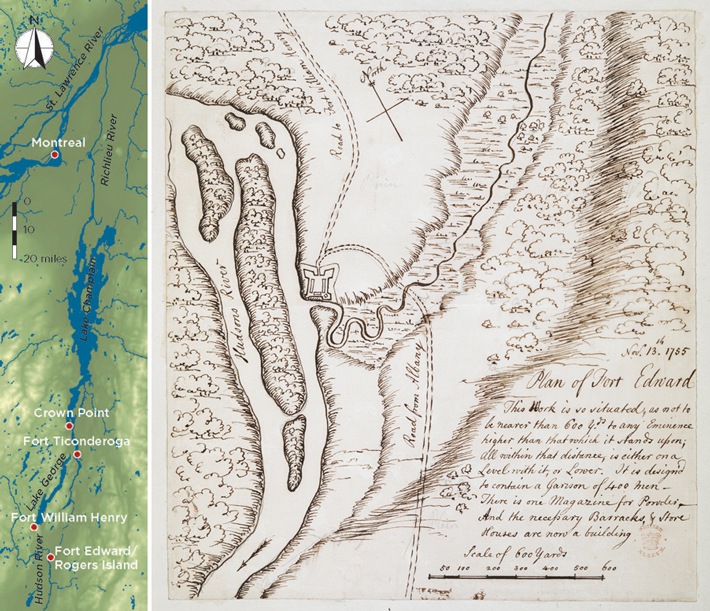
In recent years, Starbuck and his team have worked along the Hudson River about 13 miles south of Lake George, in the modern town of Fort Edward, which was named after the eighteenth-century British fortification, and on Rogers Island, which lies a few hundred feet away in the middle of the Hudson River. The modern town of Fort Edward is rather nondescript, but in the mid-eighteenth century, it was the site of the largest British military encampment in North America. In fact, between 1757 and 1759, as many as 15,000 soldiers were stationed at the fort, making it the third-largest British settlement in America at the time, behind only New York and Philadelphia. None of the fort’s original infrastructure is visible, as it lies buried deep beneath the town. But, periodically, Starbuck and other archaeologists have been able to gain small glimpses. This has often involved the unusual process of digging in people’s front yards or crawling through their basements. “There are military encampments everywhere under the streets of Fort Edward,” says Starbuck.
Construction on the fort began in 1755, early on in the French and Indian War. By that time, English colonies had spread along the eastern seaboard, from Maine to Georgia, and west to the Appalachian Mountains. The French, on the other hand, controlled a swath of territory that essentially enveloped the English. It extended through the Saint Lawrence Valley in Canada, across the Great Lakes, and down the Mississippi River to Louisiana and the Gulf of Mexico. As English colonists gradually pushed north and west, they inevitably pressed against lands claimed by the French throne. Relations between the French and the English were like a tinderbox waiting to explode. Some historians believe that it was a 21-year-old British lieutenant colonel named George Washington who ultimately lit the spark when he ambushed French troops in what is now western Pennsylvania. The ensuing conflict eventually snowballed into a global war involving most European powers, which was fought not only in North America, but also the Caribbean, mainland Europe, and as far away as India.

During the mid-1750s, much of the conflict was centered on upstate New York’s strategic waterways. While intense fighting occurred at locations such as Fort Ticonderoga and Fort William Henry, no meaningful shots were fired at Fort Edward. Archaeology at the former sites reveals details about war, siege, and massacre. Archaeology at Fort Edward reflects soldiers’ daily activities and the logistics of eighteenth-century military life. It is where British soldiers lived and were stationed before being sent to fight in the combat zones to the north. “Fort Edward is that last big base camp where everybody gathered,” Starbuck explains. “It is where the supplies were amassed and where the training was done before they pushed toward French positions.” These were the soldiers who were buried in the unmarked graves that have been occasionally rediscovered by construction projects.

The best place to closely examine the lives of British soldiers through the artifacts they left behind has been Rogers Island. During the course of the French and Indian War, the island was the centerpiece of the military complex at Fort Edward and would have been abuzz with activity. It had hospitals, storehouses, and barracks for thousands of troops. These included British regulars, enlisted American colonists, and Major Robert Rogers and his band of Rangers. Rogers, for whom the island is named, is one of the period’s most colorful and divisive characters.

During the war, the New England–born Rogers led an unconventional group of around 400 special operatives who eschewed traditional European tactics and adopted a style of fighting similar to that used by the area’s Native Americans and better suited to the terrain. They were a constant thorn in the side of the French and their allies. “Rogers’ Rangers are among the best known of the units that operated using special techniques for small unit movement and combat,” says Vandrei. “They played a key role in reconnaissance, in providing cover to armies on the march, and in harassing enemy movement and supply.”
The Rangers used the island as their main base for more than two years and it is there that Rogers is said to have codified his new fighting tactics into a series of 28 rules. “Modern U.S. special forces still read those rules of ranging, so we love to call this place the birthplace of the U.S. Army Rangers,” Starbuck says.
Excavation on Rogers Island has uncovered the remains of an array of different types of housing used by the soldiers stationed there, including large-scale barracks, tent sites, and crude cabins. There are also officers’ quarters, distinguishable by their larger size and better-quality construction, as well as the presence of artifacts, including wine glasses, fine porcelain, gold-braided uniform trim, and decorated buttons that are indicative of a higher standard of living.

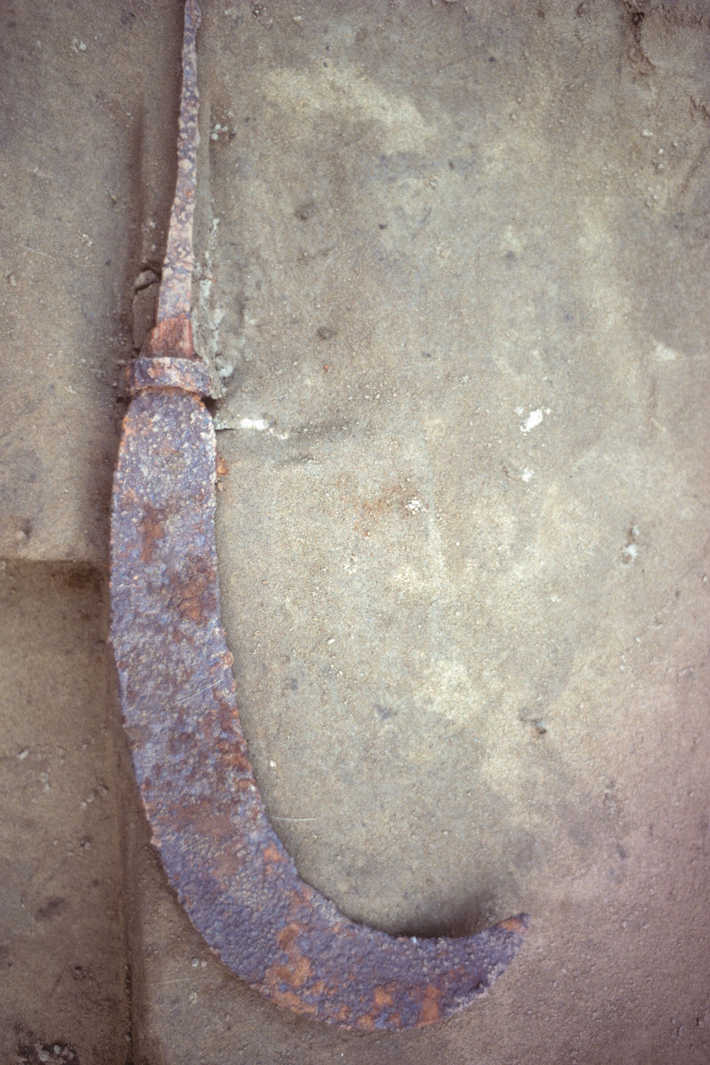
But for Starbuck, the importance of Rogers Island lies in the lives of the ordinary soldiers who were stationed here. “Most of what we find is not from the rich and the famous, but from those poor guys training here, trying to stay busy, or waiting to go and fight,” he says. “A battle may be a couple of hours, and then that’s it. Then they go home or they are dead. Rogers Island is about how they were living 364 days a year, and not simply about the one day they went to fight.”

Thousands of artifacts have been excavated from sites across the island. There are, of course, hundreds of musket balls, gunflints, and rifle parts, as each man maintained his own weapons and often made his own ammunition. There are also tools, such as axes, spades, and special fascine knives used for cutting small bundles of wood. Soldiers used these to improve their shelters, chop down trees, and prepare their fires for cooking and warmth. Occasionally the men passed the time by playing music, as evidenced by the discovery of instruments such as a jaw harp. They dressed mostly in plain uniforms, with undecorated brass buttons and buckles, which they mended using needles and thimbles. The presence of hundreds of animal bones suggests that, while the soldiers’ diet consisted mainly of pork and beef supplied by the quartermaster, they supplemented this by sneaking off to fish or hunt deer. They ate their meals on unrefined earthenware and stoneware. “Rogers Island was where men from many different colonies came together, suffered a bit from boredom and bad food, and compared notes,” says Starbuck.
The darker side of eighteenth-century military camp life—disease, rudimentary medical care, and death—has also become apparent through Starbuck’s work on the island. Dying from disease was much more of a reality for an eighteenth-century soldier than was dying in battle. Vandrei estimates that as few as 10 percent of all military deaths at the time were combat-related. “Crowded conditions, poor sanitation, poor nutrition, and a limited understanding of disease cause and transmission meant that sickness was always present,” he says. “Life in a military camp was inherently dangerous.”
Because Fort Edward functioned as a kind of staging ground, sick and injured soldiers from across upstate New York were brought to its numerous hospitals, including one dedicated to treating smallpox, which Starbuck and his teams have partially excavated. It is the only colonial military smallpox hospital to have been archaeologically investigated. Some of the most unusual objects found on Rogers Island may reflect the harsh realities of eighteenth-century medical care. Between one-quarter and one-fifth of the lead musket balls have teeth marks, perhaps caused by pigs or other animals. Alternatively, Starbuck suggests, the marks may have been left by soldiers clamping down on the soft lead to cope with the extraordinary pain of surgery performed without anesthesia. “Often soldiers did bite down on musket balls,” he explains. “If your hand or arm is being amputated, you are going to need to bite down on something or you’re going to lose your tongue.”
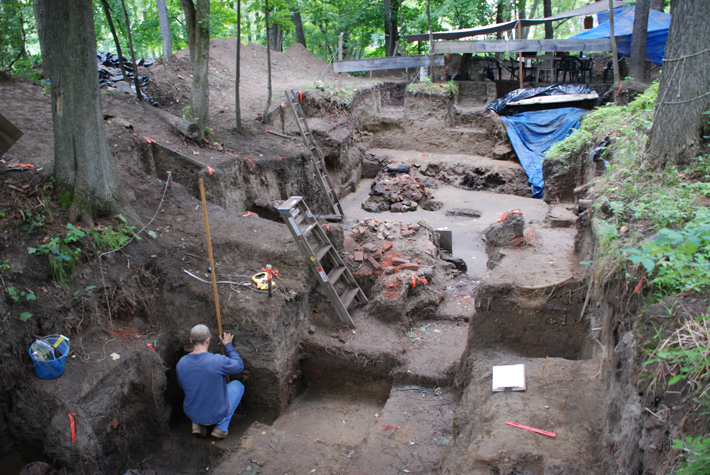
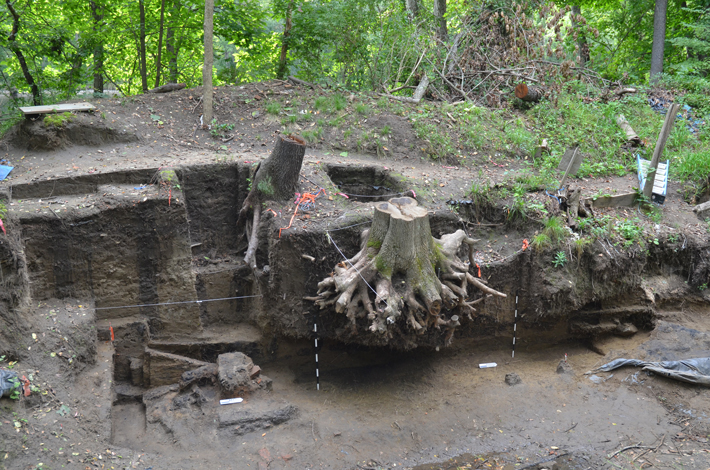
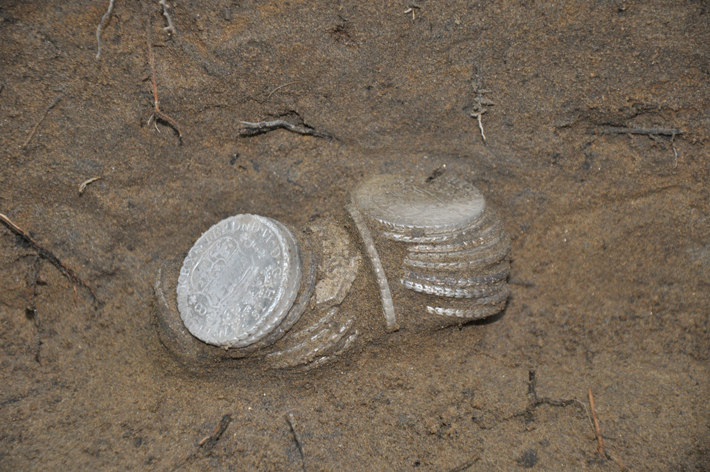
While life on the northern frontier was harsh, British soldiers did have a few places where they could relax and even purchase some of the finer things in life, which were not typically available so far from major urban centers. These were the sutlers’ houses—part tavern, part general store—where civilian merchants set up shops catering to the soldiers’ needs. One sutler’s house has been excavated by Starbuck’s teams. According to contemporaneous sources, it was owned by a Mr. Edward Best, who ran his profitable business on the outskirts of Fort Edward. “If you wanted something more, something different, or something nicer, this is about the only relief that you were going to get,” Starbuck says. “I would think on pay day you could imagine thousands of officers and men coming down to buy good stuff from the merchant here to make their lives a little bit better.”
Mr. Best’s shop burned down in 1757 or 1758, and, when it collapsed, many of the salable goods and everyday objects were buried and preserved in the cellar. These included buttons, buckles, and fasteners; military items and tools such as bayonets, musket parts, and spades; and dining ware such as plates, dishes, glasses, cups, and utensils. And, perhaps not unexpectedly in a community of soldiers, there were thousands of broken tobacco pipes and more than 10,000 wine bottle fragments. “If you had some extra cash, what would you want to buy?” Starbuck asks. “Booze and tobacco. What a great place to do business. Fifteen thousand guys, all waiting to drink and smoke.” Since the sutler’s house was a commercial establishment, it is also unsurprising that a large number of coins have been discovered there—more coins than Starbuck has ever seen at a military site. An especially high concentration was unearthed near a wooden staircase leading down to the storage cellar where soldiers would have stood with their coins in hand, waiting for their mugs to be refilled.

Unbeknownst to Starbuck, the site’s greatest cache had remained out of reach for many years, concealed beneath a large tree that had grown out of the cellar. Because of the tree’s enormous size and complex root structure, Starbuck had simply dug around it. Fortunately, the tree had also deterred looters who had been scavenging the site for many years. “No looter had ever wanted to dig through the tree roots,” says Starbuck. “We hadn’t either.” A few years ago, however, he finally resolved to remove the tree and discovered a stack of 20 Spanish silver dollars buried in the cellar floor, amounting to a small fortune in the 1750s. Starbuck’s theory is that Best, who, according to written sources from the time, was deep in debt, had put the money aside in case he was forced to leave quickly. When his business burned down, Best’s stash of coins was buried and trapped beneath debris. “I don’t think he was able to get to his traveling money,” says Starbuck. “I think he just plain took off. For the rest of his life he probably wished he could have run in to get it before he left.”
At the conclusion of the French and Indian War, the British Empire had won almost all of France’s North American territories. The events that transpired along the Great Warpath and the soldiers who passed through Fort Edward were instrumental in that outcome. Some of them, such as Robert Rogers, are famously associated with the fort. Many other young men who spent time there would only later become household names during the American War of Independence, among them Benedict Arnold and Paul Revere. However, thousands of anonymous soldiers lived and died in these woods and on these waterways. It is their lives that are finally coming into view. “We keep coming back here because I sense they have a history here that is hard to duplicate anywhere else,” says Starbuck. “Fort Edward and Rogers Island feel like places where archaeology can make a difference. It may not be as glamorous as the site of a massacre or a battle, but the stories here might be a little bit deeper.”




